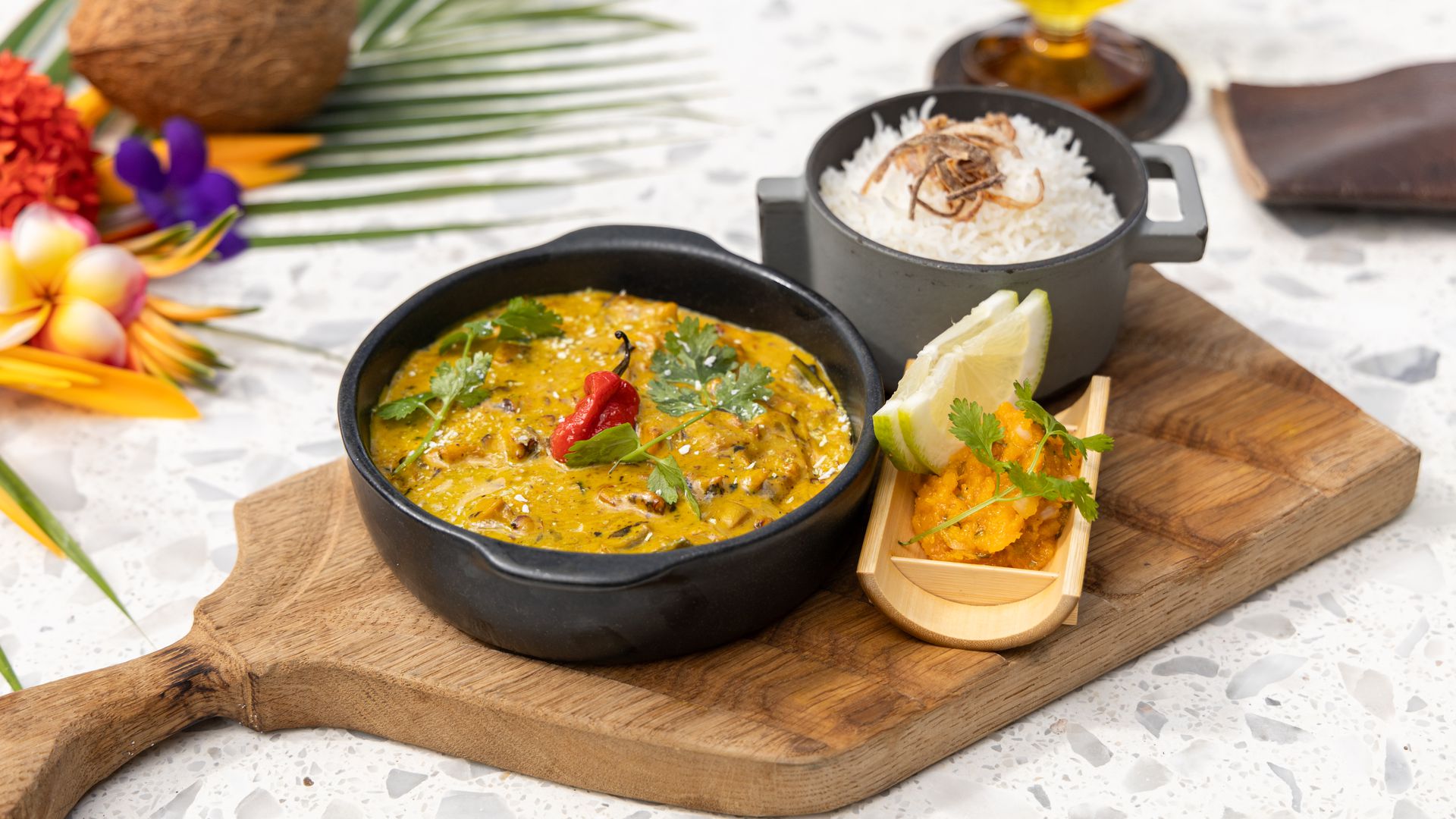
COCONUTS HOLD SEYCHELLES TOGETHER
When Seychelles’ Sir Selwyn Selwyn-Clarke Market opens for trading, the chefs of Mahé, the largest of the archipelago’s 115 islands, descend from hotels, luxury resorts, and independent restaurants. They raid the fish bars for the catch of the day, much to the chagrin of the eager herons lurking over the shoulders of the chatty fish vendors. By mid-morning, tourists and locals join the fray at the open-air market, perusing the maze of stalls brimming with colorful fruits, tropical spices, and homemade crafts.
Vendors haggle with customers in Seychellois Creole, French, and English, striking deals on lasos piman (chile sauces), cured fish, cardamom, and cinnamon. Their wares reveal the mosaic of culinary influences that intertwine in the nation’s cuisine: French, Indian, Malagasy, Chinese, British, Mozambican.
Amid the cornucopia of produce and goods, there’s one item that appears on nearly every table in varying shapes and forms: coconut. Vendors peddle homemade coconut oils in clear plastic bottles, offer ready-to-drink coconuts punctured with straws, and pile whole fruits for display. Locals stock up to make coconut milk and cream at home, while restaurants and roadside joints utilize the fruit in fragrant curries and creamy desserts.
The coconut is the thread that binds the multi-hyphenate Seychellois Creole cuisine, and the islands’ people, together. It has also helped define the country’s relationship to the outside world, at once a symbol of local pride and an economic bellwether for the shifting tides of various national industries.
In 1770, when the French first settled in Seychelles, a previously uninhabited archipelago, the Europeans built the first economy on sugar, maize, rice, and cotton, labor intensive crops farmed by enslaved people the French (and British) brought from nearby Mauritius and Mozambique and later from India and Madagascar. After the abolition of slavery in 1835, farm owners shifted cultivation to the less laborious coconut, including varieties transplanted from Malaysia, India’s Nicobar Islands, and Sri Lanka.
By 1860, coconut oil and copra, the dried flesh of the coconut used to produce coconut oil, were virtually the only exports. In the first half of the 20th century, almost 25,000 acres of land throughout the relatively small colony were under coconut cultivation, and Seychelles was supplying the United Kingdom, France, South Africa, India, and Mauritius with coconut products. The locals took to it as well.
“Traditionally, every part of the coconut was utilized [in local cuisine],” says Seychellois chef Nadine Moncherry, who heads up the kitchen at contemporary Creole restaurant Moutya at the Mango House resort. Unlike people in some tropical cultures who only use coconut for its meat and water, Seychellois embraced the whole fruit. “The husk was used for kindling fires, the shells were crafted into products like cups and candle holders, and the copra was processed into oil for hair care and skin treatments.”
Coconut didn’t just bring people to Seychelles. Over the centuries, it became a common culinary medium for techniques and perspectives contributed by each community.
The French established the cuisine’s foundation with techniques like pot roasting, baking, frying, smoking, and salting; an echo of French dishes like daube, the winey Provençal sweet and savory beef stew, can be found in ladob, a savory dessert made of sweet potato or cassava stewed in coconut milk with spices. Enslaved Malagasy people introduced ways to fish, cook rice, and make coconut milk, a method they likely learned from Austronesian peoples in prehistoric times. Later, Chinese and Indian merchants and enslaved Indian people contributed an array of spices and produce like tamarind, turmeric, and bilimbi (a tart fruit), as well as spice-filled coconut curries.
“I think many Seychellois feel that there are just some dishes you wouldn’t even attempt to make without fresh coconut,” says Steven Rioux, rum blender at Takamaka Distillery, where the island’s local coconut rum, Takamaka Koko, is produced. “Coconut milk, in particular, we use across so many dishes to bring that creaminess and that coconut flavor.”
Especially during World War I and II, when the islands were most isolated from the outside, these influences merged into a cohesive Creole cuisine. Today those foodways are clearest at takeaways, casual roadside joints that serve homestyle food mostly to a crowd of locals.
The popular Juliana’s Villas Café in Au Cap, for instance, regularly sells out of beloved, coconut-packed Creole classics like kari koko (coconut curry) featuring octopus or breadfruit, alongside items like shark chutney (grated shark mixed with citrus, turmeric, and onion), and rougaille saucisse (French sausage stew). Down the road, locals gather at Maison Marengo for live music on Saturday nights, coconut-laden curries, and moreish desserts, including ladob and nougat, a French-inspired dessert made with shaved coconut.
“Coconuts aren’t just a culinary ingredient in Seychelles,” Moncherry says, “but a versatile resource deeply ingrained in our culture.”
Take kalou, one of the oldest uses for coconut. Residents string plastic bottles to coconut palms to catch the sap, which is then naturally fermented by the fruit’s native yeast. The beverage, imbibed since the islands’ settlement, remains a staple at beachside Sunday barbecues, common occurrences in Au Cap and Anse Royale on Mahé, as well as larger celebrations like weddings.
“A party is not the same without kalou,” Rioux says.
But other traditions surrounding coconut have faded over the years, as younger generations have moved away from traditional cooking methods in favor of fast food options.
For example, Rioux explains, coconut milk was traditionally always made fresh for curries and desserts. “I remember my mother had a bench grater that she would use to process the coconut flesh before harvesting the milk from it,” he says. But most restaurants use canned coconut milk these days.
The coconut industry started a steady decline in the 1960s due to increased production costs and stiff competition from other coconut oil producing countries, especially the Philippines and Indonesia. Pakistan’s decision to stop buying coconuts from Seychelles in 1994 decimated what was left of the industry. Some older residents also draw a link between globalization and the loss of traditional foodways, a process hastened by the opening of Seychelles’ international airport in 1971. The event was a big deal for the country, vastly expanding the tourism market, but it also shifted the island’s economic and cultural priorities away from coconuts.
Tourism has dominated the Seychelles economy for decades, but in recent years, there’s been a notable resurgence of coconuts. Small-scale farmers have revived abandoned plantations, and the Seychelles National Institute of Culture and Heritage has set up initiatives to preserve Seychellois traditions, including coconut-based foodways, such as the annual Kreol Festival.
For the last decade, the Islands Development Company (IDC), Seychelles’ largest coconut oil producer, has been exporting raw coconut oil to Mombasa, Kenya, where it is used mainly for cooking and lighting. The company hopes to grow into other markets by touting its sustainable harvesting practices. It acquired a mill in 2021 to ramp up production, and it’s developing new medicinal and wellness products for both local use and export. Tinaz Wadia, director of people and culture at Four Seasons Seychelles, says the IDC has also been restoring coconut plantations on the country’s outer islands for production, including on the hotel’s home island, Desroches.
Chefs are building on the renewed interest with fresh spins on familiar, coconut-laced favorites. The most creative offerings are at resorts, the same properties that have been driving the tourism industry for so long.
Alongside the classic salad palmis (coconut palm salad), Moncherry uses coconut milk at Mango House to soften fresh red snapper for ceviche, also flavored with mango, coriander, and lemon, and she ends meals with panna cotta made with fresh coconut milk and cream. Kannel, the Four Seasons’ Mediterranean-inspired restaurant, offers select Creole staples like salad palmis and bouyon blan (fish soup), but the pineapple coconut cloud stuns at dessert with local cinnamon-infused pineapple, passionfruit gel and sorbet, and an airy coconut foam. The hotels incorporate coconut elsewhere as well: fresh coconut water and coconut chocolates at check-in, coconut-filled dinners at resort restaurants, bags woven from palm trees, and wellness treatments with names like “The Miracle of the Coco de Mer.”
Luxurious dishes and spa treatments may seem many degrees removed from the vendors haggling over coconuts at the Sir Selwyn Selwyn-Clarke Market, but they exist on the same evolutionary line. From shells crafted into candle holders in the early colonial era to milk manipulated into foam at contemporary resorts, coconuts have remained the economic and cultural expression of choice for Seychellois, whether they want to reaffirm their roots or pave the way for a sustainable future.
As Wadia puts it, quoting her elders, in Seychelles, “If there was no coconut, there would be no life.”
Tyler Zielinski is a London-based food and drink writer with a passion for cocktail culture, bartending technique, and as a proud New Jersey native, Italian American cuisine. In addition to his writing, he is the founder of Zest, a U.K.-based social media and marketing company designed to service the drinks industry, and is the author of the forthcoming book Tiny Cocktails (Clarkson Potter, 2025).
2024-07-01T14:09:51Z dg43tfdfdgfd
